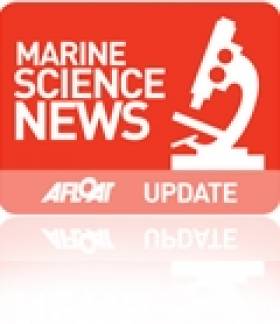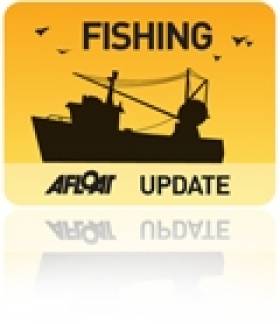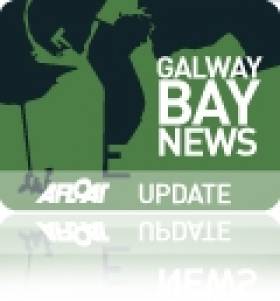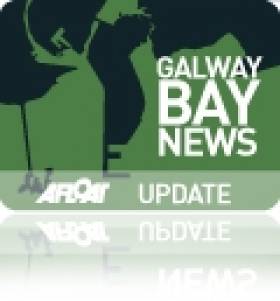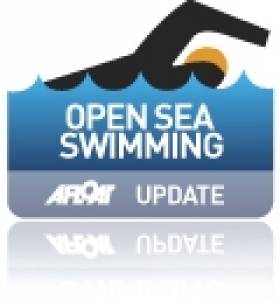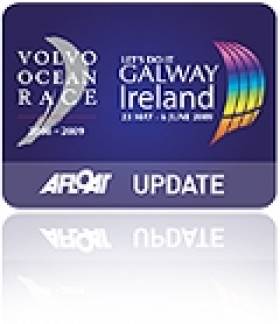Displaying items by tag: Galway Bay
Galway's Sea2Sky Celebrates European Researcher’s Night in Ireland
#MARINE SCIENCE - Galway will celebrate European Researchers’ Night on Friday 28 September together with 320 cities around Europe with its latest Sea2Sky event.
Sea2Sky, organised by NUI Galway in collaboration with the Marine Institute, Galway Atlantaquaria and its new partner CIT Blackrock Castle Observatory in Cork, will showcase science on the grandest of scales themed around marine science, atmospherics and astronomy.
The main events will be held at the Galway Bay Hotel, Leisureland and Galway Atlantaquaria, with events also taking place in CIT Blackrock Castle Observatory in Cork.
“Irish researchers are involved in some huge European research projects, and this is an opportunity to share some of the most exciting elements with the public," said event organiser and NUI Galway physics lecturer Dr Andy Shearer.
"At third level, we have seen a surge in applications for science related courses and this event will be a real draw for anyone tempted by a career in science and research.”
Last year some 10,000 people came to the event, and the plan is for an even bigger event this year, with highlights including the CERN exhibit, 3D tours of the universe and tours of the aquarium. This year visitors can participate in experiments, competitions and quizzes, watch demonstrations and simulations, exchange ideas and get to know the researchers on the free family day.
Among the showcase exhibits at the Marine Institute will be the ROV Holland 1 and a weather buoy. Scientists and technicians will be on hand to explain the work of their equipment and recent expeditions.
Inside, Marine Institute scientists will exhibit work relating to the marine environment (such as algal blooms), weather monitoring and oceanography, advanced mapping techniqyes, research vessel operations conducted by the R/V Celtic Voyager and R/V Celtic Explorer, and the Explorers Education Programme, which highlights the seashore as a vital teaching resource.
There will also be screenings throughout the day of a short film showing the newly discovered and previously uncharted field of hydrothermal vents along the Mid-Atlantic Ridge captured by Holland 1 last year.
Footage of the cold water corals and life under the sea at depths of 3,000 metres taken during the Biodiscovery and Ecosystem Survey of the Whittard Canyons will also be shown.
This year, Sea2Sky is linking up with the Galway Science Forum’s exhibition about the work of CERN – Accelerating Science. This exhibition, sponsored by Boston Scientific in partnership with NUI Galway, will show how CERN’s Large Hadron Collider can help us understand fundamental questions about the origins of the universe.
For further details of the event, visit www.sea2sky.ie.
Marine Notice: Firing Exercises Off Gormanston & Survey Equipment in Galway Bay
#MARINE WARNING - Seafarers are advised to steer clear of upcoming surface-to-air firing exercises off north Co Dublin, as well as a survey equipment deployment operation in Galway Bay.
Marine Notice No 51 of 2012 outlines that the Defence Forces will be conducting live surface-to-air firing practices at Gormanston Air Defence Range in Co Meath this week on Wednesday 19 and Thursday 20 September from 11am to 3pm each day.
Similar to the exercises conducted this past July, an exclusion zone will be established comprising the land, air and sea areas contained within a radius of three nautical miles centred on Gormanston Aerodrome, with an additional segment centred on the aerodrime and bearing of 015 degree true through Mosney rail station and 106 degrees true through Gormanston rail station seawards for a distance of 10 nautical miles.
The exclusion zone D1 will be enforced by a Naval Service vessel. All mariners in the area are required to remain outside the exclusion zone while the range is active, and are recommended to carefully monitor the radio navigation warnings that will be broadcast throughout the firing period.
Meanwhile, in Galway Bay two Benthic Lander devices will be deployed between 24 and 26 September, to be recovered between 29 and 31 September.
The national research vessel R/V Celtic Voyager (call sign EIQN) - which will host the Science@Sea marine science training scheme this coming November - will carry out the deployment of the 2-3-metre high devices that will monitor sediment movement, current speed and direction, and wave motion at depth.
All vessels, particularly those engaged in fishing, are requested to give the vessel and wide berth of at least 500 metres and keep a sharp lookout.
Details of relevant co-ordinated are included in Marine Notice No 52 of 2012, a PDF of which is available to read or download HERE.
New RnaG Radio Series on Galway Bay Fishing Industry
#FISHING - A new radio series on developments in Galway's fishing industry is part of the new autumn schedule on Raidió na Gaeltachta.
As the Galway Advertiser reports, Ballach, Bradán agus Bairneach is funded through the Broadcasting Authority of Ireland's Sound and Vision scheme and will cover the changes experienced in fishing in Galway Bay from Famine times till the present day.
Topics to be covered on the seven-part series, presented by former RnaG station head Tomás Mac Con Iomaire, include traditional fishing methods and classic fishing boats, the establishment of Bord Iascaigh Mhara (BIM), the effects of European fisheries policy, and contemporary developments such as fish farming that have prompted some recent controversy.
Ballach, Bradán agus Bairneach will be broadcast Saturdays at 6.30 pm, with the first programme tonight 15 September focusing on fishing in olden times and the folklore surrounding it. Link to the show here.
Getting Into the Smarts Behind SmartBay as Noise Data Project Switches On
#MARINE SCIENCE - Apart from some of the world's largest concentrations of wave energy, the waters of Galway Bay and the west coast of Ireland are now providing something potentially even more valuable - information.
That's according to IBM's Harry Kolar writing for the blog A Smarter Planet, as he discusses the start of his company's new underwater data collection project developed in association with the Sustainable Energy Authority of Ireland (SEAI) and the Marine Institute.
As previously reported on Afloat.ie, the system comprises an array of noise sensing equipment such as hydrophones deployed in Galway Bay to monitor the noise levels produced by wave energy conversion devices in real time.
This array is attached to a large monitoring buoy about 2km from the southern shore, and constantly transmits the data it records to a receiving system on land.
The scheme, which was finally switched on last month, is an offshoot of the SmartBay initiative for developing and testing new marine technology to foster future commercial development in the fast-growing marine science sector. The 'Twitter buoy' deployed for the Volvo Ocean Race finale recently is another of the project's schemes.
"Initially, the system will capture and analyse the ambient noise of the ocean to establish a baseline of acoustics including natural and anthropogenic (man-made) sound sources including vessel traffic," writes Kolar.
"But the ultimate goal is to capture and analyse the sounds and vibrations of hulking wave energy conversion machines that have begun bobbing along off the coast and help determine what, if any impact the sound waves from those devices could have on marine life – but especially highly sensitive dolphin, porpoise, and whale populations."
A Smarter Planet has much more on the story HERE.
Fish Farm Delays Not 'Inexplicable' Say Environmental Campaigners
#FISHING - Environmental campaigners have lambasted the IFA's claims of an "inexplicable delay" in the State's processing of licence applications for fish farms.
In a letter to The Irish Times yesterday, Tony Lowes of Friends of the Irish Environment says that the delay – to allow for proper environmental studies to be conducted – "has been explained again and again" by Minister for the Marine Simon Coveney.
He was responding to a letter last Friday by Richie Flynn of IFA Aquaculture, who highlighted the "suffering" of coastal communities as a result of processes that "hamper development and delay investment in the hundreds of companies involved in farming salmon, oysters, mussels, trout and other species".
Lowes writes in counter that salmon farming "is a highly polluting industry", and that discharge of nitrogen and phosphorous from aquaculture facilities "can fuel toxic algae blooms, which have cost the shellfish industry dear".
He claims that the proposed salmon farm in Bantry Bay in West Cork would have a nitrogen and phosphorous discharge "equivalent to the sewage of a town 10 times the size of Bantry".
Lowes also alleges that the deep-sea "super salmon" farm in Galway Bay - the licence application for which is undergoing statutory consultation till 2 October - would produce the equivalent effluent of a city more than double the size of Galway.
In addition, he makes reference to the threat to native salmon in Irish rivers through sea lice infestations.
"The EU habitats directive requires baseline studies and environmental impact statements," writes Lowes. "Licensees can be granted only if the project will not have adverse impacts on protected species and habitats."
Statutory Consultation Underway for Galway Bay Salmon Farm Licence
#FISHING - Bord Iascaigh Mhara (BIM) has begun the process of statutory consultation as the next step in its licence application for the controversial proposed deep-sea fish farm in Galway Bay.
As previously reported on Afloat.ie at the end of June, Ireland's fisheries board had announced a "significant delay" of four to six weeks before publishing the licence application.
But in a recent statement, BIM announced that it received permission some weeks ago from the Department of Agriculture, Food and the marine to begin the statutory consultation process, in which it is sharing the licence application and Environmental Impact Statement "with a list of State bodies for their appraisal and feedback".
The statutory consultation will continue till Tuesday 2 October 2012, and BIM promises that all feedback will be made available to the public via the BIM website "to further assist them in their assessment of the Environmental Impact Statement when it goes to full public consultation".
The 15,000-tonne organic salmon farm would be located off Inis Oírr in the Aran Islands on a 500-hectare site, and would be one of the largest of its kind in Europe, projected to be worth €103 million annually for the economy.
BIM intends to franchise the licence, should it be approved, to a third party "who agrees to a legally binding contract to farm the Atlantic salmon to the highest organic and environmental standards". Approval of the project could also see the creation of as many as 500 jobs, some 20% more than previously estimated.
The news comes after the ministerial apprival of salmon farm licence assignments from five separate operators in nearby Connemara, designed to "consolidate and revitalise" aquaculture in the region.
But the Aran Islands scheme has faced opposition from local anglers who fear that the fish farm could have a detrimental effect on wild salmon numbers.
Explaining BIM's plans for the consultation process, the statement added: "Previously, both statutory and public consultation would have been carried out in parallel. However, Ireland has recently (June 2012) ratified the Aarhus Convention. The convention lays down rules to promote citizens involvement and to improve public consultation in the making of decisions with potential environmental impact by the state.
"Given the recent ratification of the Convention and for a number of other legal and technical reasons, the Minister for Agriculture, Food and the Marine, Simon Coveney TD, has signed a new Statutory Instrument (SI No 301 of 2012), bringing into law new periods of public consultation for fish farm licence applications. In this instance the Department of Agriculture, Food and the Marine have instructed BIM to carry out statutory consultation in full before proceeding with public consultation.
"BIM believes that this approach will help to further inform the public during their period of consultation."
No E.coli Risk for Galway Ironman Triathlon Say Organisers
#GALWAY BAY - Organisers of the Ironman 70.3 triathlon in Galway next weekend have given assurances that no competitors are at risk from E.coli contamination - despite concerns over elevated levels of the bacteria in Galway Bay.
The Evening Herald reports that E.coli levels in the waters off Salthill were recently found to have exceeded the EU mandatory safety threshold - similar to that which saw seven beaches closed in Cork last week, as well as Rush South in Dublin over the August bank holiday weekend.
Subsequent testing showed that levels had dropped below the safe limit, and Galway City Council was yesterday expecting a second set of results which, if positive, would see the beach at Salthill reopened to bathing.
The swim portion of the Ironman triathlon on Sunday 2 September will take a route along the Salthill Promeade from Blackrock to Palmer's Rock, and organisers say they are happy that the event "will not be impacted" by the current concerns.
"We are at the far end of the bay. The event is still eight... days away and this won't affect us in the least," said organiser Eoin McCormack.
A number of Irish celebrities will be taking part in the second annual Ironman 70.3 Galway event.
Rosanna Davison, Kathryn Thimas, Keith Duffy, Ray D'Arcy and Gráinne and Síle Seoige will be among those tacking the gruelling course that includes a 1.9km swim, a 90km bike ride and a run through the Salthill and Claddagh areas of Galway City.
The Evening Herald has more on the story HERE.
New Galway Port Development Plans Revived
#GALWAY HARBOUR - Plans for a €200 million deepwater port in Galway Harbour have been revived, according to The Irish Times, as harbour bosses seek to exercise a clause in the EU habitats directive.
As previously reported on Afloat.ie, plans for the port were withdrawn after the failure of the Galway Harbour Company to secure the necessary approvals for preliminary site investigation works.
The original development proposed transferring port operations from the existing single-dock facility south into Galway Bay, where reclaimed land in deeper waters would accommodate larger cruise liners as well as a freight rail link and a 200-berth marina.
Galway Harbour Company chief executive Eamon Bradshaw said the company was now taking a new route after examining previous planning applications involving sensitive habitats.
He pointed out that under article 6.4 of the EU habitats directive, applications for projects classified under “imperative reasons for overriding public interest” allow developers to compensate for any infringement on senstive habitats by restoring an area of a similar size in a different location.
Bradshaw added that consultations are under way with An Bord Pleanála and other State agencies.
Galway Bay Swim Celebrates Seventh Year This Saturday
#GALWAY BAY SWIM - The Galway Advertiser reports that the seventh annual Frances Thornton Memorial Galway Bay Swim will take place this Saturday 28 July.
Some 40 hardy souls will brave the waters for the 13km swim from Aughinish in Co Clare to Blackrock Tower in Salthill with the aim of raising €50,000 for Cancer Care West.
The swim will also pay tribute to Páraic Casey, who tragically died last weekend while attempting to cross the English Channel.
Among those taking part in Galway Bay will be Irish international open water swimmer Chris Bryan, who narrowly missed out on a spot at the London Olympics.
The numbers are up on last year's swim, which saw 25 competitors - including Athlone man Jim O'Connor, who as reported last year was swimming up to 30km each week at his local pool in preparation.
And the event comes just a month after the Open Sea Swim Competition which formed part of the Volvo Ocean Race finale in the City of the Tribes.
More details of the swim are availabe at facebook.com/galwaybayswim
#VOLVO OCEAN RACE - It has been revealed that a new coastal radar system developed at NUI Galway was instrumental to the success of the PUMA team in the in-port races at the recent Volvo Ocean Race finale.
The radar system, which measures currents and waves throughout Galway Bay on the hour, is run by Dr Mike Hartnett’s research group in the newly launched Ryan Institute at NUI Galway.
The sophisticated system is normally used for advanced marine research, but PUMA Ocean Racing performance coach Robert Hopkins Jr contacted the researchers to see if their radar data could be used by his crew to get the edge on the CAMPER team, with which they were tied on points.
Maps of the currents in the bay over the past month were made available to PUMA and Dr Hartnett advised team on their sailing strategy for the important race.
PUMA went on to win in great style and win the series by a one-point margin. The win also marked PUMA’s first trip to the top of the podium for an in-port race in this round of the Volvo Ocean Race.
PUMA finished on the podium in nine of the 10 in-port races, collecting 45 total points to win the overall In-Port Race Series.
Hopkins was delighted with the result. “Currents in Galway Bay were a big factor in the in-port race, where tides, wind and river outflow make it all very complicated," he said. "To prepare for the race, we looked for surface current patterns in hundreds hours of data from the NUI Galway radar, took on-the-water readings before the start, and data from Mar Mostro’s own Doppler velocity log supplied by Nortek AS. It worked and we won the race.”
The NUI Galway radar data will soon be available online to the public, hopefully helping local sailors to improve their performance.
Dr Hartnett acknowledged the assistance provided by two local businessmen in enabling this advanced technology.
“The Spiddal radar site is sending its data back to the computers at NUI Galway via the broadband service of An Crúiscín Lán, thanks to the permission of owner John Foy.
"Similarly, Liam Twomey, general manager of the National Aquarium of Ireland, Salthill, provided access to their broadband to courier the Mutton Island radar data back to NUI Galway.”





























